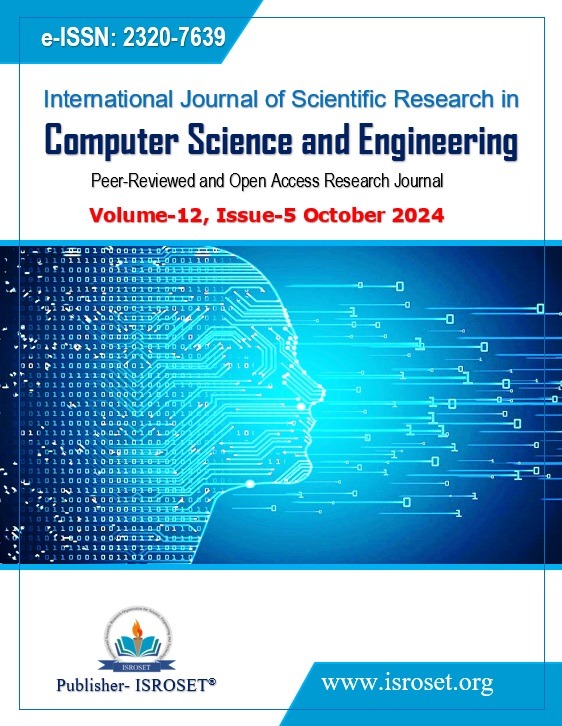Aspect-Based Sentiment Analysis for Hotel Reviews Using a Data Augmentation Approach
Keywords:
Feature Extraction, PAM, Aspect-based Sentiment Analysis, Topic ModellingAbstract
The amount of user-generated textual material created by social networks, blogs, forums, and e-commerce websites is increasing at an astronomical pace. When it comes to determining the success of a product or service, the opinions of customers are critical. Due to this, interest in FE exams and assessment mining has surged. Angle`s put-together feeling examination depends on extracting item qualities from client assessments utilizing subject demonstrating and Latent Dirichlet Allocation (LDA). Because of information sparsity and the non-appearance of co-event designs in short texts, LDA won`t be quickly applied to client audits and other short texts. Various methods have been distributed for adapting the latest models like LDA for short. A Pachinko Allocation Model (PAM) is proposed in this paper as a one-of-a-kind methodology for opinion examination because of perspectives. The Pachinko Allocation Model is a new PAM adaptation that extracts product aspects. Data augmentation increases the text data set size for the text classification task. After that, features are extracted using TF-IDF-IC-SDF and TF-IGM methods, and the fine sentiment is extracted utilizing the opinion lexicon. According to the findings of the experiments, PAM is a competitive method for extracting aspects. The outcomes of the trial show that the novel sentiment classification approach is competitive in terms of product extraction. A statistical test has also been conducted.
References
J. Singh, G. Singh, & R. Singh, “Optimization of sentiment analysis using machine learning classifiers,” Human-centric Computing and information Sciences, Vol.7, Issue.1, pp.1-12, 2017.
M. Al-Smadi, O. Qawasmeh, M. Al-Ayyoub, Y. Jararweh, & B. Gupta, “Deep Recurrent neural network vs. support vector machine for aspect-based sentiment analysis of Arabic hotels’ reviews,” Journal of computational science, Vol.27, pp.386-393, 2018.
P. Kalarani, & S. Selva Brunda, “Sentiment analysis by POS and joint sentiment topic features using SVM and ANN,” Soft Computing, Vol.23, Issue.16, pp.7067-7079, 2019.
L. Haghnegahdar, & Y. Wang, “A whale optimization algorithm-trained artificial neural network for smart grid cyber intrusion detection,” Neural computing and applications, Vol.32, Issue.13, pp.9427-9441, 2020.
W. Maharani, D. Widyantoro, H. Khodra, “Aspect extraction in customer reviews using syntactic pattern,” Procedia Computer Science, Vol.59, pp.244-253, 2015.
Q. Liu, Z. Gao, B. Liu, & Y. Zhang, “Automated rule selection for opinion target extraction,” Knowledge-Based Systems, Vol.104, pp.74-88, 2016.
C. Liao, C. Feng, S. Yang, & H. Huang, “Topic-related Chinese message sentiment analysis,” Neurocomputing, Vol.210, pp.237-246, 2016.
S. M. Rezaeinia, R. Rahmani, A. Ghodsi, &H. Veisi, “Sentiment analysis based on improved pre-trained word embeddings,” Expert Systems with Applications, Vol.117, pp.139-147, 2019.
M. E. Mowlaei, M. S. Abadeh, & H. Keshavarz, “Aspect-based sentiment analysis using adaptive aspect-based lexicons,” Expert Systems with Applications, Vol.148, pp.113-234, 2020.
M. Hu,& B. Liu, “Mining and summarizing customer reviews,” In Proceedings of the tenth ACM SIGKDD international conference on Knowledge discovery and data mining, pp.168-177, 2004.
Danial Haider, Tehreem Saboor, Aqsa Rais, "Internet of Things (IoT) and their Intrusion: Solution and Potential Challenges," International Journal of Scientific Research in Computer Science and Engineering, Vol.12, Issue.4, pp.32-47, 2024.
P. Jansson, & S. Liu, “Topic modelling enriched LSTM models for the detection of novel and emerging named entities from social media,” In 2017 IEEE International Conference on Big Data (Big Data), pp.4329-4336, 2017.
Y. Jo, L. Lee, &S. Palaskar, “Combining LSTM and latent topic modeling for mortality prediction,” arXiv preprint arXiv:1709.02842,2017.
G. Pergola, L., Gui, & Y. He, “TDAM: A topic-dependent attention model for sentiment analysis, “Information Processing & Management, Vol.56, Issue.6, 2017.
Y. Ma, H. Peng, & E. Cambria, “Targeted aspect-based sentiment analysis via embedding commonsense knowledge into an attentive LSTM,” In Proceedings of the AAAI conference on artificial intelligence, Vol.32, No.1, 2018.
A. B Dieng, F. J., Ruiz, & D. M. Blei, “Topic modeling in embedding spaces, “Transactions of the Association for Computational Linguistics, Vol.8, pp.439-453, 2020.
R. Bhargava, S. Arora, & Y. Sharma, “Neural network-based architecture for sentiment analysis in Indian languages,” Journal of Intelligent Systems, Vol.28, Issue.3, pp.361-375, 2019.
S. Xiong, K. Wang, D. Ji, & B. Wang, “A short text sentiment-topic model for product reviews,” Neurocomputing, Vol.297, pp.94-102, 2018.
A. García-Pablos, M. Cuadros, &G. Rigau, “W2VLDA: almost unsupervised system for aspect based sentiment analysis,” Expert Systems with Applications, Vol.91, pp.127-137, 2018.
Yojitha Chilukuri, Ulligaddala Srinivasarao, "Generative Adversarial Networks Using Name Entity Recognition Model Using Clinical Health Records," International Journal of Scientific Research in Computer Science and Engineering, Vol.12, Issue.4, pp.1-7, 2024.
W. Li, & A. McCallum, “Pachinko allocation: DAG-structured mixture models of topic correlations,” In Proceedings of the 23rd international conference on Machine learning, pp.577-584, 2006.
W. Li, & A. McCallum, “Pachinko allocation: Scalable mixture models of topic correlations,” J. of Machine Learning Research. Submitted, 2008.
H. Niemi, “Stochastic Approximations in the, “In Proceedings of the Third Finnish-Soviet Symposium on Probability Theory and Mathematical Statistics, Turku, Finland, August, pp.13–16, 2020.
S. Baccianella, A. Esuli, & F. Sebastiani, “Sentiwordnet 3.0: An enhanced lexical resource for sentiment analysis and opinion mining,” In Proceedings of the Seventh International Conference on Language Resources and Evaluation (LREC`10), 2010.
G. Csányi, &T. Orosz, “Comparison of data augmentation methods for legal document classification,” Acta TechnicaJaurinensis, Vol.15, Issue.1, pp.15-21, 2022.
Z. Jiang, B. Gao, Y. He, Y. Han, P. Doyle, & Q. Zhu, “Text classification using novel term weighting scheme-based improved TF-IDF for internet media reports,” Mathematical Problems in Engineering, 2021.
K. Chen, Z. Zhang, J. Long, J., & H. Zhang, “Turning from TF-IDF to TF-IGM for term weighting in text classification,” Expert Systems with Applications, Vol.66, pp.245-260, 2016.
Downloads
Published
How to Cite
Issue
Section
License

This work is licensed under a Creative Commons Attribution 4.0 International License.
Authors contributing to this journal agree to publish their articles under the Creative Commons Attribution 4.0 International License, allowing third parties to share their work (copy, distribute, transmit) and to adapt it, under the condition that the authors are given credit and that in the event of reuse or distribution, the terms of this license are made clear.







